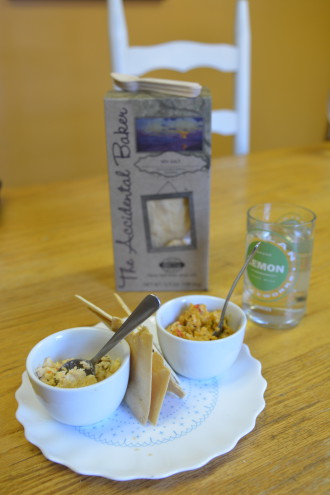Marlisa Mills didn’t realize when she took a job in Connecticut that pimento cheese really is a Southern thing. “I went into a Shaw’s grocery store and asked where they kept the pimento cheese, and you’d have thought I’d asked for fried goldfinch,” says Mills, who moved back to Buncombe County earlier this year. “That’s when I knew I’d have to make my own.”
But she couldn’t find her preferred mayonnaise — Duke’s — so she had it shipped to her. By the case.
Pimento cheese may be a Southern thing, but it originated in the North — New York state, to be precise. It was an early “scientific” food, industrially produced and marketed. The scientific food movement grew out of the women-led Domestic Science movement in the late 1800s to bring order and reason to the home, most specifically in cooking and eating.
With the invention of cream cheese in the late 19th century in Upstate New York and the introduction of canned pimentos from Spain about the same time, someone decided that putting the two together would be a good idea. Manufacturers — and homemakers — jumped on the wagon. The first published recipe for pimento cheese appeared in 1908, according to Southern Living. It called for cream cheese, mustard, chives and minced pimentos, and it caught on.
The imported pimentos weren’t always easy to find, and they weren’t cheap. So when farmers in Georgia began to grow them, it could have led the way for pimento cheese to become a Southern staple. Although at the time, most of the commercially made product was manufactured in the North, it was distributed nationally.
Variations on a theme
Before World War II, most cookbooks didn’t offer recipes for pimento cheese but treated it as an ingredient to be purchased, writes South Carolina-based food writer Robert Moss in an article for Serious Eats. By then, the cream cheese version had pretty much lost its appeal in the North, but enterprising Southerners took it in a new direction.
In the 1940s, someone decided that grated hoop cheese (a mild cheddar) might be even tastier than mashed cream cheese. Although some still make pimento cheese with mashed soft cheeses (think Velveeta), most today use grated cheddar and other harder cheeses.
“I think mashing it makes it slimy,” Mills says. She uses a mix of yellow and white cheddars and, of course, Duke’s mayonnaise, a dash of lemon juice, a dash of paprika and little Worcestershire sauce.
Early Girl Eatery adds a dash of bourbon. And although Mills has her own recipe, she still loves to taste other people’s versions. “It’s nice to be able to buy it when you don’t have time to make it,” she says.
Recently, she discovered True South’s traditional cheddar cheese pimento spread with pecans, calling it “the best I’ve ever bought.”
True South is an offshoot of Colorful Palate Catering in Arden, which opened in 2002. Co-owner Tara Letts says she and business partner Ragan Evans Lewis decided to split the pimento cheese business from the rest of the catering three years ago because demand was so high.
The product has done well, and unlike restaurant varieties, it’s available online as well as in some retail outlets, including Roots & Fruits and Merry Wine Market in Black Mountain. It’s also on the menu at the Woolworth Walk Soda Fountain and Barley’s Taproom in Asheville.

The traditional spread with pecans is the most popular of the four varieties True South makes (El Diablo, with cheddar cheese and hot pepper, horseradish havarti and smoked gouda are the other three), and it’s the one Mills discovered recently.
“It’s like the nut-coated cheese balls your mother used to make for church suppers,” Letts says. “People love it.” True South uses a little bit of cream cheese in its recipe to make the consistency creamier, Letts says.
Quality counts
While there are almost as many recipes for pimento cheese as there are people who love it, aficionados all agree on one thing: You need to use quality cheese.
Rob Voigt is general manager at Loretta’s in Asheville, which is known for its grilled pimento cheese sandwiches and for the Big Bad Wolf (pimento cheese, pulled pork, ham, bacon, coleslaw and Creole mustard). “I don’t use Velveeta because it’s well, one molecule away from plastic,” Voigt says. “The trick to good pimento cheese is good cheese.”
Like many traditional Southern foods, pimento cheese is comfort food, Voigt says. “It’s like having a bowl of soup in the winter,” he says.
Julie Strehling, co-owner of Early Girl Eatery, says part of the comfort of pimento cheese is that so many Southerners remember it from happy childhood events — family picnics, church suppers, weddings. And although she didn’t grow up with it, she pretty much fell in love at first bite.
Early Girl kitchen manager Michael Lamb thinks the appeal of pimento cheese is its high fat content. “All that delicious fat,” he says. “That’s what we love about it.”
Early Girl uses a local farmstead cheese from Yellow Branch Farms for its pimento cheese, along with a dash of cumin, a little bourbon and homemade mayonnaise. “That alone makes ours unique,” says Lamb, who notes that the restaurant’s grilled pimento cheese sandwich is one of its biggest sellers.
The spread’s versatility could also be a reason for its popularity — you’ll find it as a dip, in a sandwich, on hamburgers, and sometimes eaten all by itself. “The thing is, this is part of Southern life,” Mills says. “You can’t have a party without it.”




“A couple of years ago, a change in vendors resulted in a change in the pimento cheese. You’d have thought they’d mowed down every azalea along the course. Masters faithful don’t like it when you mess it with their pimento cheese.” http://www.southernliving.com/dairy/cheese/the-masters-pimento-cheese